This is a mash-up of Shrimp and Pork Belly Vietnamese Spring Rolls with Thai Pad Thai, creating a sweet, spicy, and tangy noodle dish with fresh bean sprouts, napa cabbage, red bell pepper, carrots, scallions, and cucumber.
The noodles and vegetables are dressed in a spicy chili garlic peanut sauce and garnished with toasted peanuts tossed in fresh basil and mint, making this the best shrimp and pork belly pad Thai meal with a twist.

Table of Contents
Jump to:
Vietnamese and Thai Fusion
Immerse yourself in the vibrant fusion of Shrimp and Pork Belly Pad Thai - Spring Roll Style, where Vietnamese spring rolls' beloved textures and flavors collide with the iconic Thai Pad Thai.
This dish is an adventurous foodie's delight, featuring succulent shrimp and rich pork belly mingled with a crunchy medley of fresh bean sprouts, napa cabbage, crisp red bell pepper, carrots, scallions (green onions), and cucumber.
Spicy Kick!
Each bite is enrobed in a spicy chili garlic peanut sauce that delivers a fiery kick tailored for those who cherish a little heat on their palate. The noodles and crisp vegetables provide a satisfying crunch, enhanced by a garnish of toasted peanuts that have been delicately tossed with fresh basil and mint, adding a refreshing and aromatic finish.
Perfect for spice enthusiasts, this dish promises a tantalizing, tangy experience with every forkful, celebrating a bold blend of cultures in one spectacular creation.
Pad Thai History
Pad Thai is a famous street food dish from Thailand that has an interesting history. It was first introduced in the 1930s when rice was the main staple food in Thailand. The Prime Minister at the time, Plaek Phibunsongkhram, created Pad Thai to reduce rice consumption and promote a sense of national identity.
The recipe used cheap and easily available ingredients such as rice noodles, bean sprouts, and peanuts, making it accessible to everyone. Over time, Pad Thai has become even more popular and has evolved to include proteins like chicken, shrimp, or tofu. It's a symbol of Thai culinary ingenuity and is loved by both locals and international food lovers.
Vietnamese Spring Rolls History
Vietnamese spring rolls, known locally as Gỏi cuốn, have their origins in the regions around the Mekong Delta, where fresh produce and seafood are abundant. These rolls are a celebration of Vietnam's vibrant agrarian lifestyle, encapsulating the freshness of local herbs, pork, shrimp, and vermicelli noodles (thin rice noodles), all wrapped neatly in translucent rice papers.
Historically, they emerged as a variant of the Chinese spring roll. However, Vietnamese spring rolls forgo frying for a fresher approach, reflecting the Vietnamese penchant for fresh ingredients and delicate flavors.
This culinary delicacy gained prominence during the mid-20th century as Vietnam sought to carve out a distinct identity that mirrored its tropical resources and culinary ethos. Today, Vietnamese spring rolls have become a staple in Vietnamese cuisine, symbolizing health and prosperity, and are enjoyed in various adaptations around the world.

Looking for Authentic Vietnamese and Thai recipes? Check out Vicky Pham and Hot Thai Kitchen.
More Recipes with Bold Flavors
- Shishito Eggplant Shrimp Stir-Fry
- Best Spicy Sauteed Chili Lemon Garlic Shrimp and Vegetables
- Jalapeño Pesto and Argentinian Shrimp Pasta
- Spicy Creole Shrimp and White Cheddar Cheese Risotto
- Fresh Hoisin Mushrooms Noodle Bowl with Spicy Peanut Sauce
Ingredients
For the Prep
Begin by soaking the rice stick (Pad Thai) noodles in warm water as instructed on the package and setting them aside. While the noodles are soaked, make the garlic chili peanut sauce by combining chunky peanut butter, fresh lime juice, brown sugar, fish sauce, and garlic chili sauce, then set it aside.
Next, cut the vegetables for the stir fry by cutting napa cabbage, carrots, and red bell pepper into thin strips. The green and white parts of the scallions on separated and cut into thirds and halves. Then, fresh mint and basil leaves are chopped smaller and set aside. Finally, the pork belly is cut into thin strips, and the garlic is chopped.
For Cooking the Pad Thai
Start by toasting crushed peanuts in a wok until golden brown. Toss the chopped herbs in a bowl and set them aside. Next, stir-fry the vegetables, remove them, and set them aside. Then brown the pork belly with scallions and chopped garlic. Add the shrimp and cook them halfway. Add the stir-fried vegetables with fresh cucumbers cut into thin strips and the garlic chili peanut sauce, and heat the pad thai all the way through.
For the Plate
Plate the shrimp and pork belly pad Thai and garnish with fresh bean sprouts and lime wedges. Then, garnish the top with chopped herb peanuts.
See the shrimp and pork bell pad Thai recipe card for quantities below.
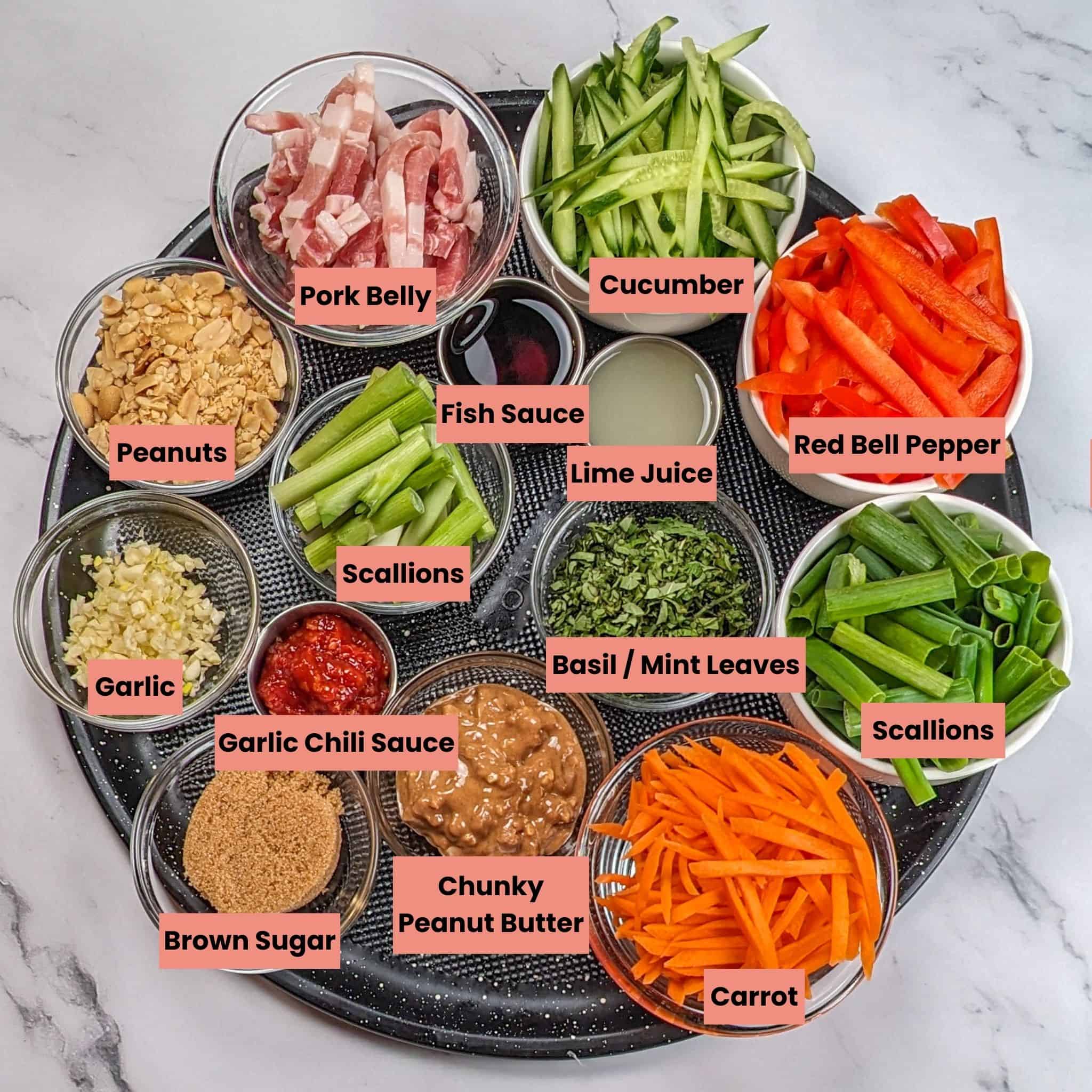



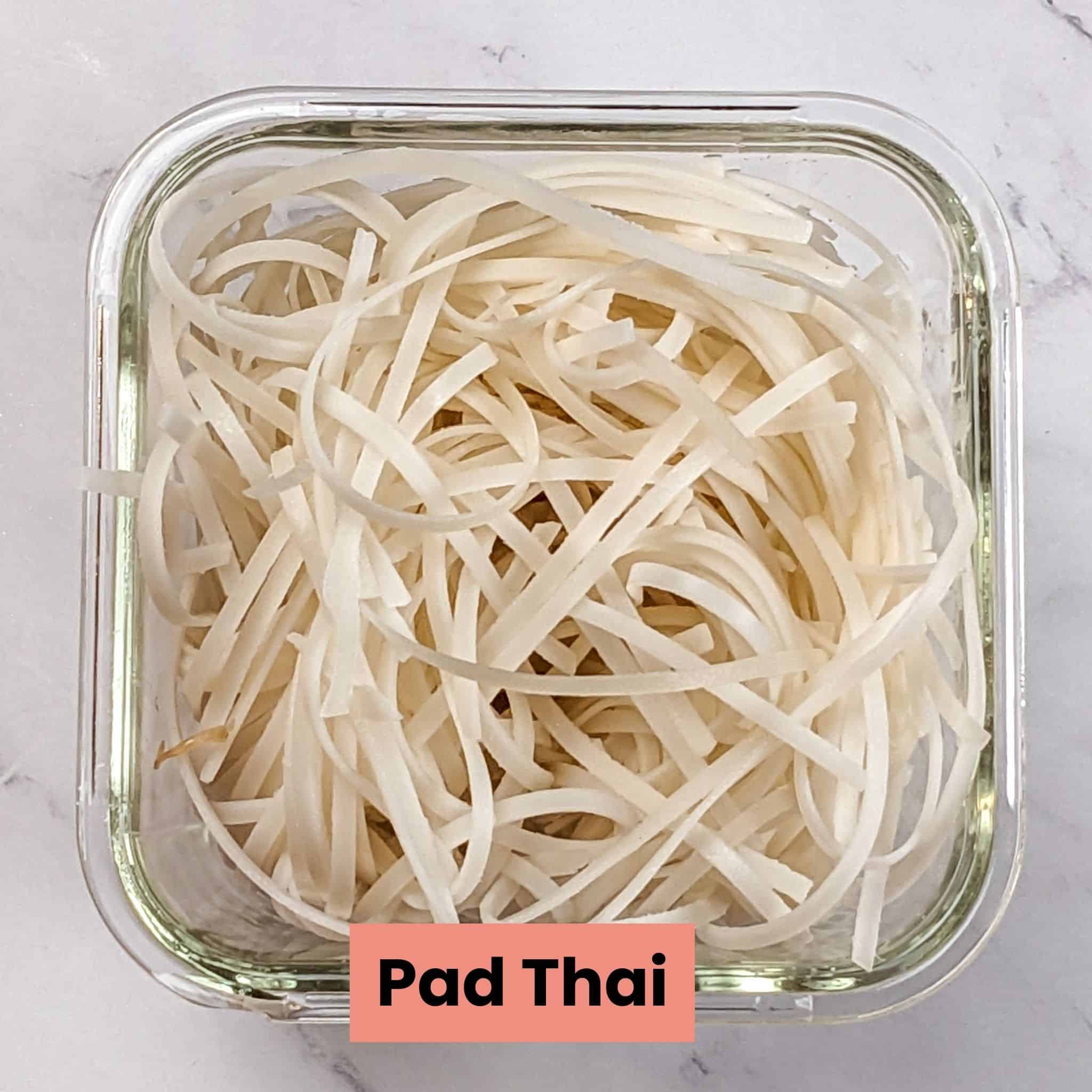
Instructions
Follow the instructions and cooking tips below using the step-by-step picture guide.
Prep

Whisk the ingredients for the garlic chili peanut sauce together, creating a vibrant red-brownish sauce. This sauce should have a sweet, spicy, and sour balanced taste. If you use a good brand of fish sauce, like Squid Brand, the overall taste in the sauce will be mellow with a salty-sour kick.

Constantly stirring the peanuts on medium-high heat will prevent them from burning; make sure to have a bowl ready to pour them into immediately to stop the cooking process.
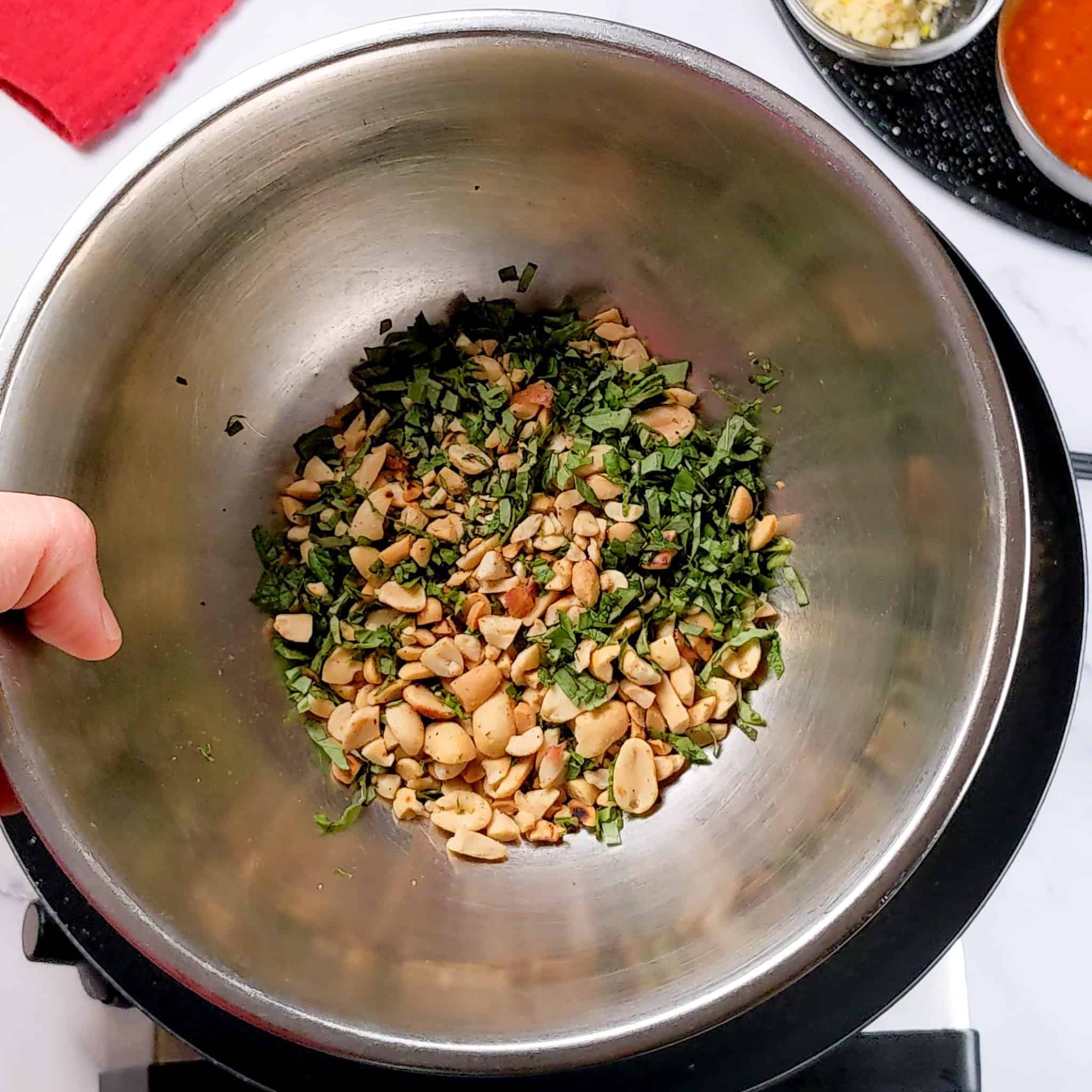
Add the fresh chopped herbs to the hot peanuts, which helps release the oils in the herbs, creating an aromatic blend.

Since the carrots take longer to cook, they are stir-fried first but only cooked halfway to keep that crunch.
Finish Stir-Fry

Next the cabbage is added to wilt and remove excess moisture.

Then, the vegetables that take a shorter time to cook are added next.

Following this order keeps the vegetables' color bright and crunchy.

When cooked uniformly, the pork belly and white part of the scallions will take about the same time to cook.
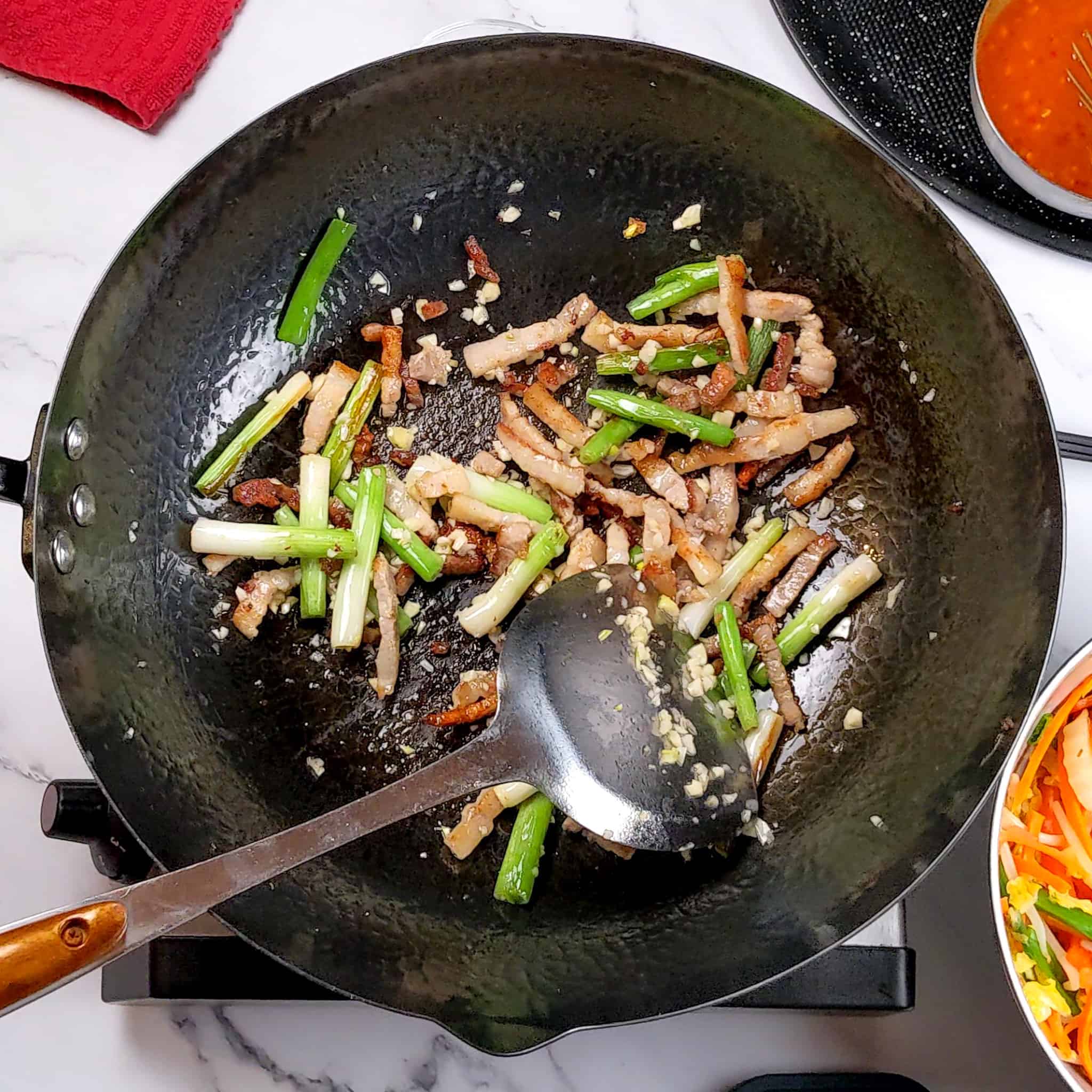
Allow the pork to brown (the Maillard reaction), creating the caramelizing that will give the browned garlic a bold flavor.

The shrimp takes the shortest to cook and is added last, and it is only cooked halfway at this point.
Pad Thai Time!

The soaked noodles should be bright white and pliable but still intact.

Remove the excess moisture from the vegetables to quickly evaporate with the noodles.

Then add the remaining ingredients at this point just to warm up.
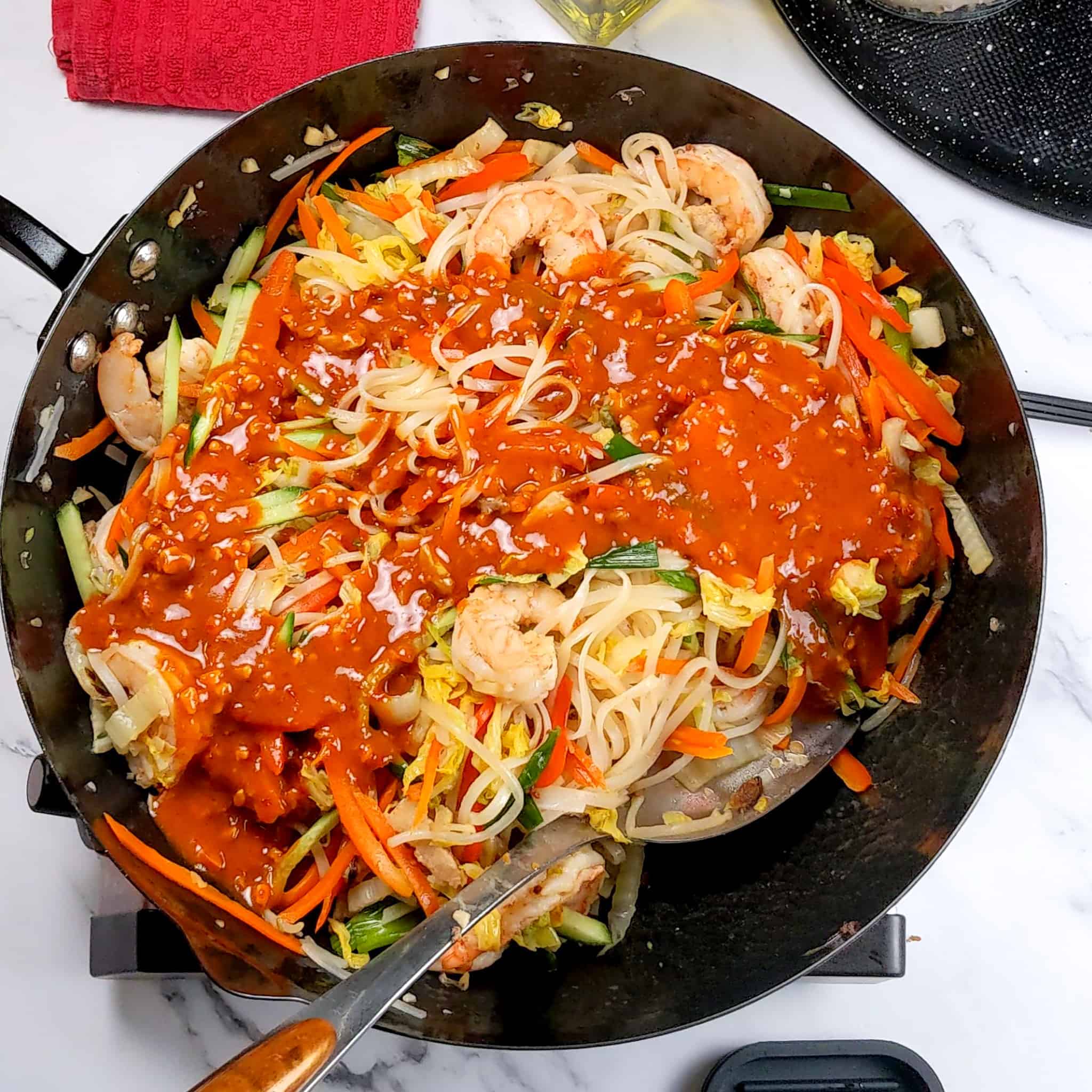
The sauce is thick with a bold flavor enough to coat all the ingredients and still have a taste.
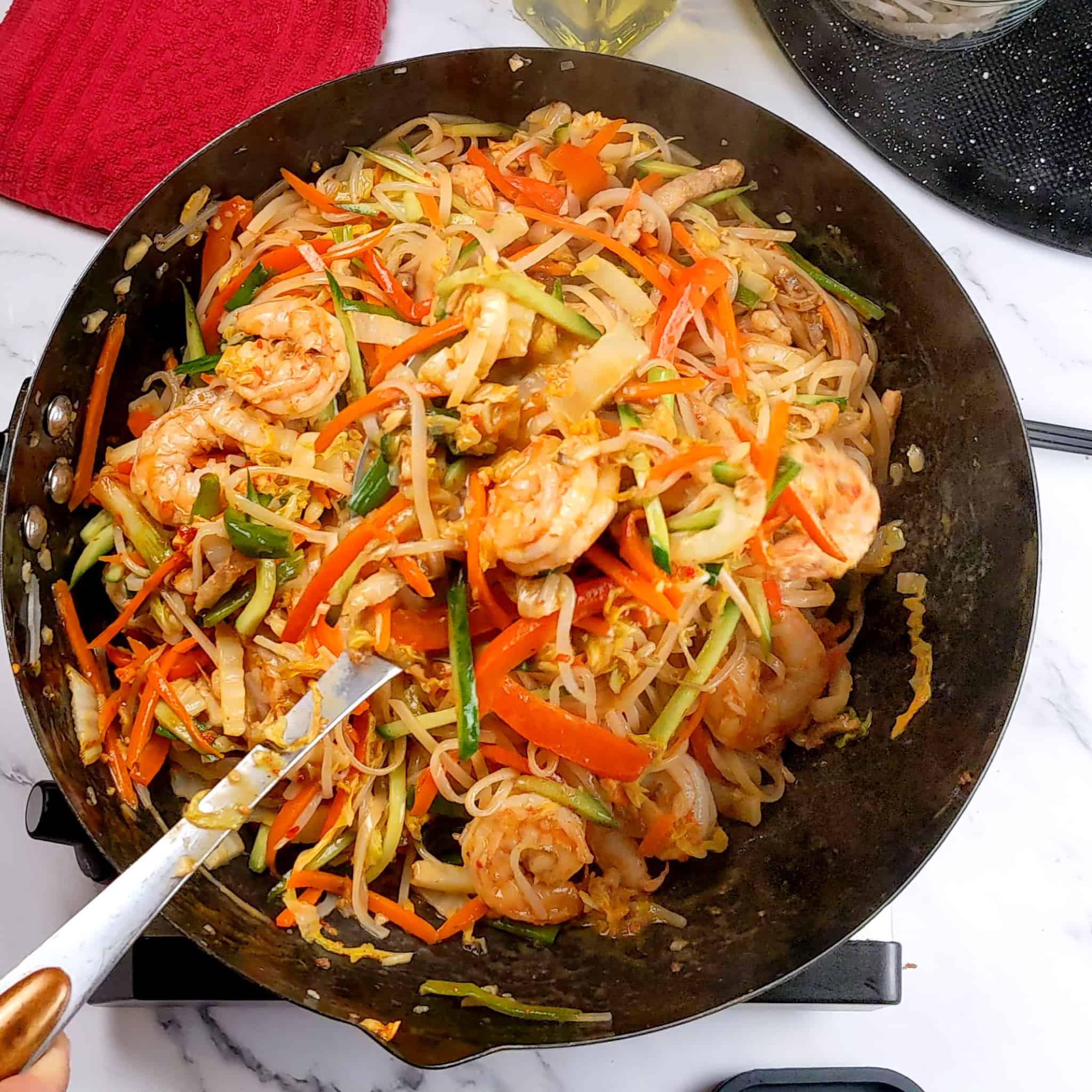
Combine well by gently folding in the pad thai while warming up to keep all the ingredients intact.
My Review: The BIELMEIER 12.5" Carbon Steel Wok is hands down my favorite wok to cook with. The size is perfect, not too big, not too small, and the flat bottom makes it super easy to use on any stovetop, especially for stir-fries and high-heat cooking. I was also impressed by the thoughtful design and the sleek packaging, which honestly makes it a great gift for anyone who loves to cook. What really stood out was the thorough set of instructions included on how to season and care for the wok, perfect for novice wok users who might feel intimidated. It’s a beautiful, functional piece that’s earned its permanent spot in my kitchen. Read my article on how to use a wok here.

Substitutions
Dairy-Free
- This shrimp and pork belly pad Thai is already dairy-free!
Gluten-Free
- This shrimp and pork belly pad Thai is already gluten-free!
Vegetarian
- Large Shrimp, Pork Belly, and Fish Sauce - For texture and umami flavor, Replace these ingredients with a combination of sliced oyster mushrooms, seafood mushrooms, and dried shitake mushrooms. Hydrate the shitake mushrooms with hot water and use the liquid towards the end of the recipe with soy sauce (or liquid aminos or coconut aminos).
Convenience
- Garlic Chili Sauce - Although garlic chili sauce tends to be thicker, you can substitute this sauce, siracha. Sirach may be saltier, so pay attention to using it to balance the fish sauce.
- Medium Rice Sticks Noodles (Pad Thai) - If you already have glass noodles or rice vermicelli noodles, you might be able to substitute them for these.
- Fresh Mint and Basil - Substitute one for the other.
- Pork Belly - You might get away with using bacon, which is made from pork belly and smoked and cured.
- Persian Cucumbers - Use English cucumber. Or try Kirby cucumbers. However, you will have to remove the seeds. Cut them in half and use a spoon to slide them down the middle to remove the seeds and pulp.
- Pork Belly - Replace with ground pork.
Change Heat Level - Modify the shrimp pork bell pad Thai recipe's heat level to your liking and learn more about the Scoville Scale and Chili Pairings.
Variations
- Shrimp Spring Rolls - Still want spring rolls? That's fine. Use this dish to stuff rice paper wrappers. Make sure to prepare the spring roll wrappers as instructed, which usually involves soaking them to make them pliable. Only use the shrimp and pork belly pad Thai after they have been cooled down. Serve with more garlic chili peanut sauce and/or hoisin sauce.
- Salad Rolls - Instead of rice paper sheets, use lettuce leaves, either rolled up or as tacos. I suggest using a delicate lettuce leaf, like romaine or butter (Bibb) lettuce. Serve with more of the garlic chili peanut sauce and/or with hoisin sauce.
Equipment
Wok - A wok is used for stir-frying because its high, sloping sides and rounded bottom allow ingredients to cook quickly and evenly at high temperatures while using less oil, making it ideal for tossing and stirring ingredients continuously. To develop this recipe, I used the 12.5" Flat Bottom Carbon Steel Wok with Lid; it is a perfect size and fits on a flat stove top without having to use a wok ring.
Kitchen Must Haves - Find other tools I use here.
-
5.0
$29.99$28.49My Review: The BIELMEIER 12.5" Carbon Steel Wok is hands down my favorite wok to cook with. The size is perfect, not too big, not too small, and the flat bottom makes it super easy to use on any stovetop, especially for stir-fries and high-heat cooking. I was also impressed by the thoughtful design and the sleek packaging, which honestly makes it a great gift for anyone who loves to cook. What really stood out was the thorough set of instructions included on how to season and care for the wok, perfect for novice wok users who might feel intimidated. It’s a beautiful, functional piece that’s earned its permanent spot in my kitchen. Read my article on how to use a wok here.
Buy on AmazonPurchased: July 12, 2022We earn a commission if you make a purchase, at no additional cost to you.
12/08/2025 09:05 am GMT -
Buy on Amazon$16.95
We earn a commission if you make a purchase, at no additional cost to you.
12/09/2025 07:06 am GMT -
Buy on Amazon$16.99
We earn a commission if you make a purchase, at no additional cost to you.
12/08/2025 11:07 am GMT -
Buy on Amazon$8.99
We earn a commission if you make a purchase, at no additional cost to you.
12/08/2025 11:02 am GMT -
Buy on Amazon$13.45
We earn a commission if you make a purchase, at no additional cost to you.
12/08/2025 11:05 am GMT -
Buy on Amazon$29.99
We earn a commission if you make a purchase, at no additional cost to you.
12/08/2025 11:07 am GMT -
Buy on Amazon$37.99
We earn a commission if you make a purchase, at no additional cost to you.
12/09/2025 08:03 am GMT -
Buy on Amazon$32.99
We earn a commission if you make a purchase, at no additional cost to you.
12/08/2025 12:03 pm GMT -
4.8
$43.99$24.04My Review: This knife is well-made. Super solid and multi-functional. It is made with high-carbon steel, so it will not rust. Slicing meat like fish is easier with the grooves. It doesn’t stick to the knife. The handle has an excellent grip, and it's not heavy. For some background, a Santoku is a versatile Japanese kitchen knife characterized by its straight edge and "sheepsfoot" blade, designed for precise slicing, dicing, and chopping. Its name means "three virtues," referring to its ability to handle meat, fish, and vegetables efficiently, making it a staple in both professional and home kitchens.
Buy on AmazonPurchased: 08/19/24We earn a commission if you make a purchase, at no additional cost to you.
12/08/2025 10:05 am GMT -
Buy on Amazon$12.99
We earn a commission if you make a purchase, at no additional cost to you.
12/08/2025 11:06 am GMT

Storage
- Refrigerator - To store in the fridge, place the shrimp pork bell pad thai in a shallow 2-inch container to cool down quickly. Then, store it in an airtight container. The meal will last up to three days.
- Freezer - I do not recommend freezing this dish due to the rice noodles not freezing well.
Airtight Food Containers
I interchange glass food storage containers with plastic clipping lids or wooden push-ins. I always suggest glass storage containers because they can be microwaved, they hold food without staining, and the glass keeps the food at a more stable temperature, keeping it fresher and longer.
Try the OXO Good Grips Smart Seal Glass Rectangle Food Storage Containers or the Pyrex Freshlock Glass Food Storage Containers.
Cooking Tip
Your Cooking Tips Resource Guide - Become a better home cook with tips to help you cook more efficiently on the Cook's Notebook tab. Learn valuable cooking tips about cooking in a wok here.
Wok Stir-Frying - For optimal stir-frying, preheat your wok until it's smoking hot before adding oil; this technique ensures a quick sear and helps prevent ingredients from sticking, preserving their texture and flavor. Learn more valuable tips on cooking with a wok here.

Frequently Asked Questions
When using a wok, opt for high-smoke point oils such as peanut, canola, or vegetable oil to withstand the high temperatures without burning, ensuring a crisp finish to your dishes. Learn more about high smoke point oils here.
When stir-frying vegetables in a wok, add the toughest and thickest vegetables, like carrots and broccoli, first and the more delicate ones, like leafy greens, last to ensure everything is perfectly crisp and tender. Learn more about cooking in a wok here.
You might be able to find it at your local grocery store. However, you are more likely to find all the ingredients at your local Asian supermarkets.
Squid Brand Fish Sauce is renowned for its robust flavor and perfect balance of saltiness and sweetness, making it a favorite for enhancing the umami depth in Southeast Asian dishes.
South East Asian Recipes
Looking for other South East Asian-inspired recipes like this? Try these:
- Garlic and Ginger Paste: A Flavor Shortcut Every Home Cook Needs
- Celebrate AAPI Heritage Month with These Top Asian-Inspired Recipes
- Quick Spicy Potstickers | Chili Momo Tibetan Style
- Bold and Spicy Caribbean Beef Noodle Soup Recipe Twist
Seafood Recipes
Are you looking for other seafood recipes like this? Try these:
- Creamy Haitian-Style Shrimp Mac and Cheese with Gouda Cheese
- Air Fryer Jerk Shrimp Fajitas | Easy Caribbean in 20 Minutes
- 20 Irresistible Fish Recipes
- Healthy Haitian-Style Creole Spicy Shrimp Pasta
📖 Recipe
Shrimp and Pork Pad Thai
Ingredients
Peanut Lime Chili Sauce
- ¼ cup creamy or chunky peanut butter
- ¼ cup fresh lime juice
- ¼ cup packed brown sugar
- ¼ cup fish sauce
- 1 tablespoon garlic chili sauce
Spring Roll Pad Thai
- 8 ounces rice stick noodles medium
- 14 ounces small napa cabbage about half of large
- 2 medium carrots peeled
- 1 medium red bell pepper
- 2 cups bean sprouts rinsed and dried
- 12 scallions 1 bunch
- 8 basil leaves
- 8 mint leaves
- ½ cup peanuts crushed
- 2 tablespoons avocado oil
- 4 ounces pork belly
- 5 garlic cloves
- 1 pound shrimp shelled and deveined
- 2 small Persian cucumbers
Garnish
- 1 lime wedges
Equipment
Instructions
- Save time in the kitchen: Read the instructions thoroughly, then gather and prep all your ingredients before cooking! Learn Prepping Tips.
- Soak the Noodles: Before gathering everything to prep, soak the noodles as instructed on the package. This takes about 30 minutes; you will have it soaking while prepping and cooking the rest of the recipe.
- Prepare the Peanut Sauce: Combine the peanut butter, lime juice, brown sugar, fish sauce, and garlic chili sauce and set aside.
- Prepare the Vegetables: Cut the cabbage, carrots, and red bell pepper into thin strips. Then, separate the scallions in half where the white and green meet, cut the green scallions into thirds, and add them to the vegetables. Finally, cut the white scallions into halves and set them aside.
- Prepare the Herbs: Chop the mint and basil together and set it aside.
- Prepare the Pork Belly and Garlic: Cut the pork belly into 2-inch-long strips. Note that it is easier to cut when thawed halfway. Then, chop the garlic and set it aside.
- Toast the Peanuts: Heat the wok on medium heat and have a medium bowl ready. Add peanuts to the hot wok and stir to brown evenly; place in the bowl, toss with herbs, and set aside.
- Stir-fry the Vegetables: Heat the wok on medium-high heat. Then, add the oil. Next, add the carrots and stir-fry for 1 minute. Add the napa cabbage, cover, and cook for 4 minutes, stirring occasionally throughout the cooking time.
- Add the red bell pepper, half of the bean sprouts, and the green part of the scallions; cover for 2 minutes to sweat. Then, remove them and set them aside in a bowl.
- Cook the Pork Belly and Scallions: Wipe out the excess liquid and heat the wok on medium-high heat.
- Then, add and cook the pork belly and the white scallions. If the pork belly is sticking, let it cook for a bit more to release it. Then, scrape the bottom and combine both ingredients well. Allow them to brown, letting them sit for 30 seconds at a time before stirring.
- After 4 minutes, most of the pork and scallions will be browned. Add the garlic and stir-fry for 1 minute.
- Finish the Pad Thai: Add the shrimp and stir fry until the side of the shrimp turns opaque and pink. Then, add the (drained) noodles and cook until wilted halfway through. If the bottom of the wok is dry and feels like it is about to burn, add the liquid from the stir-fried vegetables to loosen up the stuck food bits.
- Add the stir-fried vegetables, cucumber, and peanut sauce and heat up. Once the pad Thai is hot, immediately remove it from the heat and plate up.
- Finish the Plating: Garnish the side of the pad thai with bean sprouts and lime wedges and sprinkle the herbed nuts on top.
Video
Nutrition
Subscribe to my YouTube Channel
SUBSCRIBE: 👈To my YouTube Channel to Get Notifications of New Videos.
Have a Comment or Question?
If you have a question or comment about this shrimp and pork belly pad Thai recipe, please post it below. You will definitely get a quick response, and it will also help our other readers stay informed. Thanks!























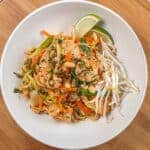




Leave a Reply